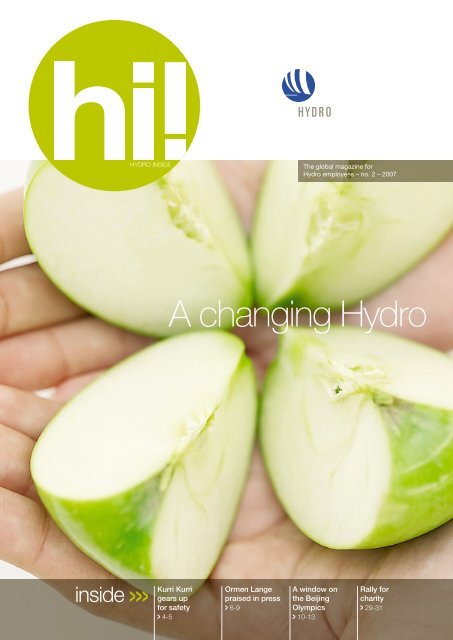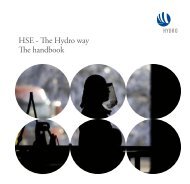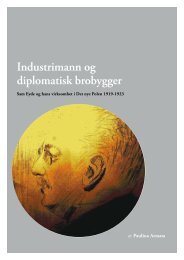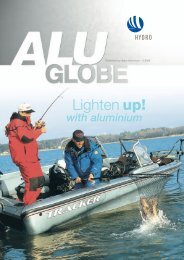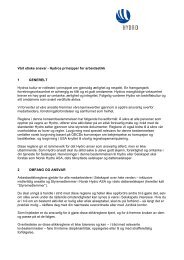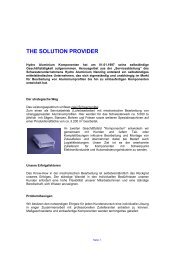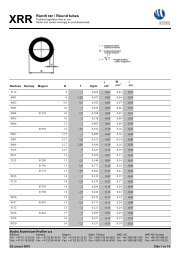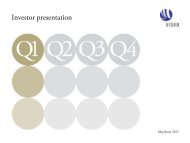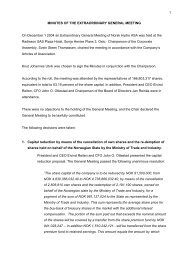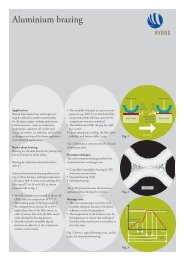You also want an ePaper? Increase the reach of your titles
YUMPU automatically turns print PDFs into web optimized ePapers that Google loves.
inside >>><br />
HYDRO INSIDE The global magazine for<br />
<strong>Hydro</strong> employees – no. 2 – 2007<br />
A <strong>changing</strong> <strong>Hydro</strong><br />
Kurri Kurri<br />
gears up<br />
for safety<br />
> 4-5<br />
Ormen Lange<br />
praised in press<br />
> 6-9<br />
A window on<br />
the Beijing<br />
Olympics<br />
> 10-13<br />
Rally for<br />
charity<br />
> 29-31
there!<br />
<strong>Hydro</strong> has undergone major changes<br />
over the past five years. But the company’s<br />
viable industrial traditions stretching back<br />
101 years, its strong market positions, as<br />
well as its talented and loyal workforce, will<br />
live on from the autumn of 2007 in three<br />
leading global companies: the fertilizer<br />
company Yara, the aluminium and power<br />
company <strong>Hydro</strong>, and in the global oil<br />
industry’s biggest offshore operator.<br />
The spin-off and merger of <strong>Hydro</strong>’s<br />
oil and gas business with Statoil is an<br />
extensive project, and many in both <strong>Hydro</strong><br />
and Statoil are facing new opportunities<br />
and challenges.<br />
Other parts of <strong>Hydro</strong>’s operations are<br />
also about to undergo big changes. It is<br />
in such situations that the quality of the<br />
employees and the organization is put to<br />
the test and is seen to prevail.<br />
I have been asked questions and<br />
listened to comments indicating that the<br />
vast majority are enthusiastic and filled with<br />
expectation regarding the changes facing<br />
them. My impression is that this applies<br />
both to those introwho textare body joining copy theintro newtext oil<br />
company T body and those copywho introare text continuing body copy in<br />
<strong>Hydro</strong> as an<br />
intro<br />
aluminium<br />
text body<br />
company.<br />
copy intro text<br />
And yet many are uncertain. What about<br />
body copy intro text body copy.<br />
me, what about my job? These are natural<br />
Body copy Body copy Body copy Body<br />
and sound reactions. I share this uncer-<br />
copy Body copy Body copy Body copy Body<br />
tainty. And every day I am with colleagues<br />
who<br />
copy<br />
are<br />
Body<br />
feeling<br />
copy<br />
the<br />
Body<br />
same<br />
copy<br />
emotions.<br />
Body copy Body<br />
copy Meanwhile Body copy myBody gut reaction, copy Body andcopy the Body<br />
reactions copy Bodyofcopy commentators, Body copy Body analysts copy andBody<br />
investors copy Body worldwide copy Body indicate copy Body that we copy have Body<br />
made copy Body the right copydecision. Body copy ThisBody is because copy Body<br />
we copy are Body making copythese Bodychanges copy Body fromcopy a Body<br />
position copy Body of strength. copy Body copy Body copy<br />
By means of bold moves and hard work<br />
we have added great value ensuring that<br />
more than 40,000 well qualified employees<br />
have jobs that are even more secure<br />
hi! > writer<br />
and exciting.<br />
photos > photographer<br />
contents<br />
4-5<br />
Safety in center. Keeping track of safety gear<br />
systematically saves money and improves safety<br />
performance.<br />
6-9<br />
Ormen Lange a star. We know the Ormen Lange gas<br />
project is a big deal. The rest of the world is taking notice,<br />
too.<br />
10-13<br />
Foot in the door in China. Isn’t exporting fabricated<br />
aluminium products to China like selling sand in the Sahara?<br />
14-15<br />
Seeing is believing. Virtual reality isn’t just for exploring<br />
undersea reservoirs – it can also improve safety offshore.<br />
16-25<br />
A <strong>changing</strong> <strong>Hydro</strong>. The proposed merger of <strong>Hydro</strong>’s<br />
oil and gas activities with the Norwegian company Statoil<br />
is certainly a big deal. But there are some other notso-small<br />
deals happening, too, that are <strong>changing</strong> <strong>Hydro</strong>.<br />
26-27<br />
When small is beautiful. Little things can mean a lot,<br />
both for the environment and the bottom line.<br />
29-31<br />
Ride of a lifetime. It takes determination. Paul Farrugia<br />
spent 16 days riding a motorbike across South Africa to<br />
help that country’s fight against poverty and disease.<br />
32-33<br />
Art and engineering – two sides of the same coin.<br />
For Joe Brown, his computer-driven engineering work and<br />
his whimsical paintings complement each other – both<br />
require foresight and determination to see them through.<br />
34-35<br />
Postcard from Newton Aycliffe<br />
hi&lo 28 hi5 36
hi!> team<br />
Editor-in-chief > Cecile Ditlev-Simonsen<br />
Managing Editor > Craig Johnson (craig.johnson@hydro.com)<br />
Editorial board > Halvor Molland (Aluminium Metal),<br />
6 10 14<br />
26<br />
29<br />
next issue<br />
May 2007<br />
Ideas? Contact:<br />
Craig Johnson<br />
<strong>Hydro</strong> (F472B)<br />
NO-0240 Oslo,<br />
Norway<br />
craig.johnson@<br />
hydro.com<br />
contents hi! 3<br />
Ole Johan Sagafos (Aluminium Products), Bjørn Otto Sverdrup<br />
(Oil & Energy), Ragnvald Bertheussen (Other Businesses).<br />
Design and production > item ltd and Media Center (3700017)<br />
Photo: Scanpix<br />
The businesses<br />
leaving <strong>Hydro</strong> will<br />
go on to create<br />
value in their new<br />
homes.
Keeping track<br />
of safety gear<br />
systematically<br />
saves money and<br />
improves safety<br />
performance<br />
Safety<br />
in the<br />
center
Team co-ordinator Michael Wilson and his colleagues at<br />
Kurri Kurri are benefiting from improved safety performance<br />
and the Safety Maintenance Center.<br />
T<br />
he aluminium smelter in Kurri<br />
Kurri, Australia, distributed close<br />
to 13,000 pieces of safety equip-<br />
ment to employees last year – a lot to<br />
keep track of. That’s the job of the Safety<br />
Maintenance Center.<br />
“When we issue a piece of safety equip-<br />
ment, we know it is according to Australian<br />
and site safety standards. It has not been<br />
lying around in the back of a car the last six<br />
months, with paint all over it,” says site safety<br />
officer Jim York.<br />
Together with assistant safety officers<br />
Gregory Cook and Simon Lane he inspected<br />
and issued close to 13,000 pieces of safety<br />
gear in 2006. This includes 3,764 Racal hel-<br />
mets, 1,791 harnesses and 1,789 lanyards.<br />
The process and results of the system are<br />
impressive, making the Safety Maintenance<br />
Center a significant contributor to a record low<br />
total recordable injury statistic of 2.1 in 2006.<br />
In addition, <strong>Hydro</strong> saves big money through<br />
loss prevention.<br />
It wasn’t always that way. Ten years ago,<br />
each worker had individual safety gear, and<br />
50 Racal helmets, each priced at around<br />
$800, were lost every year. Other equipment<br />
was misplaced and lost, and – very import-<br />
ant – safety equipment was not inspected<br />
regularly.<br />
Last year, though, only one of the Racal<br />
helmets was not returned. The Safety Main-<br />
tenance Center then could identify who had<br />
been issued the helmet, and the department<br />
in question had to replace it.<br />
Since all equipment is tagged and all activi-<br />
ties logged on a computer, the use of safety<br />
equipment can be optimized in cooperation<br />
with the manufacturer. One example is Racal<br />
helmet filters. The center now knows exactly<br />
how many times each of the 110 helmets has<br />
been used. York estimates the annual savings<br />
on filters alone to be around $30,000.<br />
“The people working at the Safety Maint-<br />
enance Center are all certified to inspect the<br />
safety equipment we issue. All equipment is<br />
clearly tagged and identified, has its designat-<br />
ed storage area, and we know exactly when<br />
it expires or requires servicing. We dismantle,<br />
clean, and inspect everything before it is re-<br />
issued,” says York.<br />
Based on this success, all contractors<br />
working at the smelter are also offered the<br />
use of safety equipment from the center.<br />
hi! > Halvor Molland<br />
photos > Halvor Molland<br />
Safety officer Jim York (right) and assistant Gregory Cook inspect a Racal helmet at the Safety Maintenance Center in Kurri Kurri, Australia.<br />
safety first hi! 5<br />
– 25%<br />
Goal!<br />
<strong>Hydro</strong> made its goal of a<br />
20 percent drop in the total<br />
number of injuries in 2006<br />
– by a good margin.<br />
The number of total recordable<br />
injuries (TRI) has been<br />
falling steadily over time,<br />
although the ambitious target<br />
of a 20 percent reduction in<br />
injuries set by President and<br />
CEO Eivind Reiten has not<br />
been reached every year.<br />
Last year, though, the trend<br />
was very positive – a reduction<br />
of around 25 percent, for<br />
a TRI rate of 4.0. The reduction<br />
in the TRI rate for 2005<br />
was 10 percent.<br />
“Certain business areas<br />
have achieved great improvements,”<br />
says Jack Simensen,<br />
head of safety in the corporate<br />
Health, Safety and Environment<br />
department. “Several<br />
units have achieved an improvement<br />
of more than 50<br />
percent, but we still have a<br />
list of units that are lagging<br />
behind, and unfortunately<br />
certain units also have reported<br />
a setback. This of course<br />
gives grounds for follow-up.”<br />
Despite the overall improvement,<br />
<strong>Hydro</strong> experienced one<br />
workplace fatality in 2006.<br />
Jens Hinrichs, a project engineer<br />
at the aluminium extrusion<br />
plant in Birtley, England,<br />
died in an accident in early<br />
November.<br />
“Every fatal accident is one<br />
too many,” Simensen says,<br />
adding that the number of<br />
fatal accidents has also fallen<br />
over time.<br />
The fatal accident at Birtley<br />
has been investigated, and a<br />
report has been distributed<br />
on the <strong>Hydro</strong> intranet so that<br />
others can learn from the<br />
experience.
We know the Ormen Lange gas project is a big deal. T
The rest of the world is taking notice, too<br />
hi! 7<br />
>>>
Ormen Lange<br />
a star<br />
H<br />
ydro’s Ormen Lange project<br />
is attracting a good deal of<br />
attention far beyond the small<br />
community of Aukra on the northwest<br />
coast of Norway, where the gas will be<br />
brought ashore for processing.<br />
So far, Ormen has been seen by millions<br />
of television viewers worldwide on Discovery<br />
Channel, as well as Russian and German<br />
programs. The Langeled pipeline part of the<br />
project, which connects the landfall site and<br />
a terminal in England, has been covered by<br />
the BBC and several UK newspapers.<br />
Here are some of the most prestigious:<br />
• The Ormen Lange project reappeared on<br />
TV when National Geographic Channel<br />
featured it in the “Megastructures” series.<br />
• Ormen Lange went to Hollywood when<br />
<strong>Hydro</strong>’s film “The Traveller,” featuring Lonely<br />
Planet host Ian Wright, won top honors at<br />
the US International Film and Video Festival.<br />
• Popular Science magazine featured the<br />
Ormen Lange/Langeled project in a “Best<br />
of What’s New in 2006” feature.<br />
• The jewel in the crown as far as the energy<br />
industry is concerned was when the project<br />
captured the esteemed Platt’s Global<br />
Energy Project of the Year prize in New<br />
York City in late 2006.<br />
“Ormen was unanimously voted into first place<br />
by all 10 of the Platt’s Global Energy Award’s<br />
judges – the first time ever in the history of the<br />
awards,” says Lars H. Bjelvin, head of Ormen<br />
Lange communication.<br />
“The project is a fantastic vehicle for getting<br />
across strategic messages supporting <strong>Hydro</strong>’s<br />
business goals. Its features and strengths are<br />
very much the same as those <strong>Hydro</strong> has devel-
oped as an industrial frontrunner during the<br />
past 100 years.”<br />
One of the most important facets <strong>Hydro</strong><br />
wants to show about Ormen Lange is close<br />
and constructive cooperation with project<br />
partners, suppliers and the public, including<br />
academia and science institutions.<br />
“Managing a project like this cultivates two<br />
other strengths that both Ormen Lange and<br />
<strong>Hydro</strong> are increasingly known for – being a<br />
technological visionary that progressively<br />
develops new, groundbreaking technologies,<br />
and being a performance champion that<br />
consistently delivers large-scale projects with-<br />
in agreed time and cost frames,” Bjelvin says.<br />
“<strong>Hydro</strong> trademarks like technology, project<br />
performance and cooperation are the ones<br />
we need to tailor and communicate to stake-<br />
holders and decision makers, bilaterally and<br />
publicly, wherever we have growth ambitions.”<br />
<strong>Hydro</strong> recently completed just such a com-<br />
munications campaign in Russia. “Today <strong>Hydro</strong><br />
is widely recognized by both Russian business<br />
and political leaders as a leading company<br />
within subsea technology and especially as a<br />
company that’s always on time and budget,”<br />
says Bjelvin.<br />
This is the fi rst time in my life that we’re getting so<br />
much focus on a project. It makes you proud when<br />
National Geographic and Discovery Channel want<br />
to cover Ormen Lange, even before we’re done.<br />
This really brings Ormen Lange to the people, and<br />
it’s very stimulating for the whole project team.<br />
Tom Røtjer, senior vice president, Projects<br />
Conveying this image is strategically imperat-<br />
ive in a country like Russia, with its abundant<br />
petroleum resources yet difficult framework<br />
conditions, which are coupled with intensify-<br />
ing competition between international com-<br />
panies that have upstream petroleum growth<br />
ambitions.<br />
“Going into <strong>Hydro</strong>’s last year as an opera-<br />
tor on Ormen Lange, the project’s trademark<br />
strengths will be steadily marketed towards<br />
other key decision makers in different parts<br />
of the world – the Americas, Europe, the<br />
Middle East and Africa, to mention some,”<br />
says Bjelvin.<br />
“We always tailor our message to the local<br />
business realities in the places where we have<br />
growth ambitions. We do it both bilaterally and<br />
publicly through a complete mix of channels<br />
in order to get the message across – Ormen<br />
Lange and <strong>Hydro</strong> is all about three features:<br />
technology, performance and cooperation.”<br />
hi! > David Burke<br />
photos > Øivind Leren, Tor Hammerstad,<br />
Helge Hansen, Dag Thorstensen<br />
hi! 9
Foot<br />
in the door<br />
in China<br />
Isn’t exporting fabricated<br />
aluminium products to<br />
China like selling sand<br />
in the Sahara?
hi! 11
If you fi nd it difficult to change your long-held perceptions you<br />
should stay away from China. Things are developing here so<br />
quickly that even the most dynamic among us are struggling to<br />
keep up.<br />
Gérard Lugrin<br />
Windows from <strong>Hydro</strong> are destined to adorn the Morgan Center in Beijing.<br />
C<br />
hina represents a vast growing<br />
market – 1.3 billion people in<br />
the fastest growing economy<br />
in the world. Demand for aluminium is<br />
increasing, but so are the abilities of<br />
Chinese producers, who are working<br />
hard to catch up to Western standards.<br />
Still, <strong>Hydro</strong> is selling its advanced alumin-<br />
ium building systems products – including<br />
for high-profile constructions connected to<br />
the 2008 Olympic Games in Beijing – for<br />
this booming construction market.<br />
Says Gérard Lugrin, who is developing <strong>Hydro</strong><br />
Building Systems in China: “Why shouldn’t<br />
we sell our advanced building systems in<br />
the world’s fastest growing market?”<br />
Lugrin operates out of a big new ware-<br />
house and office building outside Beijing,<br />
from which <strong>Hydro</strong> is currently making its<br />
first major delivery here.<br />
Wicona brand window systems from<br />
<strong>Hydro</strong> will form a highly visible part of the<br />
setting for the Beijing Olympic Games, the<br />
Morgan Center.<br />
In the last year, he has built up a staff of tal-<br />
ented Chinese employees, including several<br />
who have solid construction industry experi-<br />
ence. In the autumn of 2006 they moved into<br />
their new warehouse, signed their first major<br />
contracts and established important links with<br />
the Chinese building industry, property devel-<br />
opers, metal building specialists and architects.<br />
They have also drawn up their plans for the<br />
coming years when the Wicona and Technal<br />
brands will be developed to take their natural<br />
position in this enormous market.
The size of the Chinese market for alumin-<br />
ium building products is not that easy to<br />
gauge. Lugrin estimates a volume of roughly<br />
1 million tonnes per year for the type of pro-<br />
ducts that <strong>Hydro</strong> supplies. <strong>Hydro</strong> Building<br />
Systems’ niche in this market is probably<br />
around 100,000 tonnes.<br />
But they are not alone. Both European<br />
and Chinese suppliers are chasing shares<br />
in the market for top-quality products. More-<br />
over, the Chinese authorities are about to<br />
introduce stringent new requirements con-<br />
cerning the energy efficiency of buildings.<br />
“The new specifications outlined are<br />
intended to improve the energy efficiency of<br />
new buildings by 65 per cent,” he explains.<br />
“They will be more stringent than the most<br />
rigorous specifications in Europe.<br />
“This represents a great opportunity for us,<br />
but it also means that Chinese producers will<br />
soon catch up in this field. Several of them<br />
already deliver very advanced building systems.<br />
If we intend to keep ahead in terms of quality<br />
and technically advanced solutions, we need<br />
to intensify our product development efforts.<br />
Our most demanding clients in China do not<br />
set lower standards than our European ones.”<br />
Lugrin and his team are off to a flying start,<br />
but they know that a large and growing market<br />
Personal profile<br />
Gérard Lugrin – ‘pioneer’<br />
Gérard Lugrin has been <strong>Hydro</strong> Building Systems’ representative in Beijing for one year,<br />
but he is no industry newcomer. The 59-year-old French architect has spent his entire<br />
career in the aluminium industry, most of it with Technal, which became part of <strong>Hydro</strong><br />
in 2002. He has lived all over the world – in Morocco, Thailand, Europe and the Middle<br />
East. and traveled for 15 years in Africa, Middle East and South America. Lugrin came<br />
to Beijing from Bahrain. He describes himself as a typical pioneer. That’s what he likes<br />
doing best – setting up, building, getting the wheels to turn. Afterwards he prefers to<br />
withdraw and hand over to the locals. This is clearly the right thing to do in China.<br />
is not in itself a guarantee of success. You also<br />
need a real ability and willingness to under-<br />
stand where you naturally fit in Chinese culture.<br />
Gérard Lugrin is enthusiastic – and there can<br />
be no doubt that his people are too. He says<br />
that he faces the tasks confronting him with<br />
due humility. Moreover, he is greatly impressed<br />
by the tempo and determination in today’s<br />
developing China.<br />
“Just look around! There’s hardly a block in<br />
this huge city that isn’t dominated by several<br />
big cranes. New skyscrapers are going up all<br />
over the place. There are market opportunities<br />
as far as the eye can see,” he says. “This is<br />
tremendous. I’ve never experienced anything<br />
like it.”<br />
hi! > Ole Johan Sagafos<br />
photos > Ole Walter Jacobsen<br />
Preparations are under way<br />
for the 2008 Olympics in Beijing.<br />
hi! 13
Virtual reality isn’t just for exploring undersea<br />
reservoirs – it can also improve safety offshore<br />
Seeing
is believing<br />
F<br />
or the fi rst time, computer<br />
codes designed to analyze gas<br />
hazards are being combined<br />
with virtual reality (VR) to deliver safety<br />
training.<br />
The program has been created by the<br />
Oil & Energy Research Center in Porsgrunn,<br />
Norway, to help offshore and onshore per-<br />
sonnel to understand and reduce offshore<br />
risk, and to improve safety.<br />
<strong>Hydro</strong> platform managers gathered in the<br />
Oseberg VR room at the Sandsli offices near<br />
Bergen to take part in an interactive demon-<br />
stration of the new training tool. The program<br />
combines realistic three-dimensional com-<br />
puter-assisted design models with in-house<br />
design and gas hazard analysis tools. It is<br />
fully interactive, so you can simulate new<br />
incidents online, simply by defining a new<br />
leak and placing it wherever you like.<br />
“The main goal is to increase awareness<br />
of barrier philosophy, risk levels and to com-<br />
municate emergency preparedness mea-<br />
sures,” says project leader Olav Sæter.<br />
There’s nothing virtual about the need to im-<br />
prove awareness. Last year, <strong>Hydro</strong> accounted<br />
for nearly half of all reported gas leak incidents<br />
in the Norwegian offshore sector.<br />
“It’s not so easy to communicate risk levels,<br />
but using this tool we can see and experience<br />
virtual situations,” says Gry Offernes, head of<br />
safety, security & emergency preparedness in<br />
Operations.<br />
For example, she cites offshore workers<br />
who build makeshift wind shelters on plat-<br />
forms without consulting technical safety<br />
representatives: “This program visually dem-<br />
onstrates the consequences!”<br />
Here’s how it works.<br />
“Now we’re in a very dangerous situation,”<br />
explains Sæter, simulating a potentially cata-<br />
strophic gas leak in the compressor module<br />
on Grane, the model platform used in the<br />
<strong>Hydro</strong>-designed VR program. Sound effects<br />
of gas leaks and explosions have been in-<br />
corporated to make the situation as realistic<br />
as possible. All simulated data is generated<br />
by advanced codes for gas hazard analysis,<br />
including sites where leaks are likely to occur<br />
and wind conditions.<br />
Training scenarios are designed around five<br />
steps of development in a gas leak situation<br />
– source, gas dispersion, ignition, explosion<br />
fire and major accident. Wind also appears<br />
in the form of color-coded lines and arrows<br />
depicting directions and speeds.<br />
The VR risk and safety program can be<br />
used anywhere – from the CAVE virtual reality<br />
viewing room to laptop computer – thanks<br />
to a software application that can run on<br />
different hardware platforms. All you need is<br />
3D goggles. Even a laptop conveys the same<br />
sense of 3D depth as CAVE.<br />
hi! > David Burke<br />
photo > Vidar Hardeland<br />
It’s not so easy to communicate risk levels, but using this tool<br />
we can see and experience virtual situations.<br />
Gry Offernes<br />
Olav Sæter demonstrates the VR safety<br />
program for platform managers and other<br />
future users.<br />
hi! 15
A <strong>changing</strong><br />
inside >>><br />
<strong>Hydro</strong><br />
Eivind Reiten<br />
Photo: Helge Hansen
The proposed merger of <strong>Hydro</strong>’s oil and gas activities<br />
with the Norwegian company Statoil is certainly a big deal.<br />
But there are some other not-so-small deals happening<br />
that are <strong>changing</strong> <strong>Hydro</strong>.<br />
<strong>Hydro</strong> Polymers, which has about 1,200 employees, is<br />
to be sold or launched on a stock exchange, much as<br />
the former Agri business – now Yara – experienced three<br />
years ago. <strong>Hydro</strong> Production Partner and Production<br />
Services (more than 1,000 employees in total) are also<br />
being prepared for sale.<br />
See what your colleagues – and some former colleagues<br />
– have to say.<br />
>>><br />
<strong>Hydro</strong> Polymers’<br />
‘can-do’ attitude<br />
> 18-21<br />
Yara blazes its<br />
own trail<br />
> 22-24<br />
A <strong>changing</strong> Innovation <strong>Hydro</strong> hi! 17<br />
Bittersweet exit,<br />
but jobs remain<br />
> 24-25
‘<strong>Hydro</strong> is <strong>changing</strong>, and<br />
we’re <strong>changing</strong>’<br />
The employees at <strong>Hydro</strong> Polymers in Aycliffe,<br />
England, know how to tackle change<br />
T<br />
he chairman of Bakelite Ltd.,<br />
the fi rst company to run the<br />
industrial site at Newton Aycliffe<br />
after World War II, commented in 1951:<br />
“Workers in the North East are the finest type<br />
they could possibly be, adaptable, hard work-<br />
ing and capable of picking up new processes<br />
very quickly.”<br />
That’s certainly still true today. In the inter-<br />
vening years, other companies have done<br />
business here, with <strong>Hydro</strong> Polymers the latest,<br />
starting when <strong>Hydro</strong> acquired the site in 1982.<br />
Much of the workforce is drawn from the<br />
local area, and more than a few employees<br />
can point to family members also employed<br />
here. More than a few have worked for more<br />
than one owner.<br />
So what do they think about plans to<br />
divest <strong>Hydro</strong> Polymers, either through a sale<br />
to another company or by creating a new,<br />
independent company through a stock listing?<br />
hi! > Craig Johnson<br />
photos > Terje S. Knudsen
We have nothing to be afraid of<br />
from a new owner. We have a strong<br />
operation and good, capable people.<br />
Bill Wood<br />
Bill Wood<br />
Site director<br />
30 years<br />
A <strong>changing</strong> Innovation <strong>Hydro</strong> hi! 19<br />
‘A strong operation’<br />
Communication is important, otherwise<br />
you’re left in a black hole. Now that it’s<br />
out in the open it’s so much easier. We<br />
can explain the positives of standing on<br />
our own two feet.<br />
We believe <strong>Hydro</strong> will treat us in a fair<br />
manner. This site has a lot to be grateful<br />
for when you look at what has been<br />
developed here.<br />
I’ve worked for two owners: British<br />
Industrial Plastics, and then <strong>Hydro</strong>. We<br />
recognize <strong>Hydro</strong> is <strong>changing</strong>, and we’re<br />
<strong>changing</strong>. We have nothing to be afraid<br />
of from a new owner. We have a strong<br />
operation and good, capable people.<br />
>>>
Carl Fawcett<br />
Process operator<br />
– Compounds<br />
10 years<br />
‘Lot of uncertainty’<br />
My father has been here nearly<br />
30 years. I started in October<br />
1996 on the mixing floor in<br />
Compounds, when I was start-<br />
ing a family of my own.<br />
It’s one of the best-paying<br />
places around. I believe it’s<br />
a firm that wants to help you<br />
along.<br />
There’s a lot of uncertainty,<br />
especially among the younger<br />
lads. There are lots of plants<br />
around England that are closing<br />
down.<br />
I don’t see the divestment as<br />
a bad thing. Whatever direction<br />
we take, we can focus a bit<br />
more. The profitability is there.<br />
I’ve got three kids – 2½, 6<br />
and 11 – and live just down the<br />
road. And while I might wish<br />
something else for them, I’d like<br />
to think that something will still<br />
be here when they get older.<br />
Brent Morfoot<br />
Process operator – Compounds<br />
2 years<br />
‘New era coming’<br />
I worked for 19 years at Great Lakes Chemicals here in<br />
Aycliffe, then due to closure I applied here at <strong>Hydro</strong>, and<br />
I’ve never looked back. I always looked at <strong>Hydro</strong> as the one<br />
that did things right. When I was at Great Lakes, we’d ask<br />
ourselves, What would <strong>Hydro</strong> do? Why don’t we do that?<br />
I’m born and bred here. Wife Jill, and two kids, Stacey,<br />
16, and Carl, 13.<br />
If this divestment had happened two years ago – when<br />
times were tough and we were low on orders – I might have<br />
been worried. But we’ve had a big upturn, we’re working<br />
chockablock. I’d be more worried if I was working anywhere<br />
else than <strong>Hydro</strong>.<br />
There’s a willingness to change by the employees. We<br />
never stand still here.<br />
We’ve come through a hard time, but we’ve got a bright<br />
future. This is the pinnacle, it’s where everyone wants to<br />
work.<br />
There’s a new era coming, and if we carry on pulling in<br />
the right direction, I can see any transition causing minimal<br />
disruption. With our willingness for change and the strong<br />
teamwork ethic we have, there’s no reason why we cannot<br />
look forward with belief of exciting times ahead. Keeping<br />
our high standards and positive thinking are the keys to<br />
success.<br />
Lee Edgar<br />
Craftsman and<br />
Amicus union shop steward<br />
15 years<br />
‘Positive about the future’<br />
I started 15 years ago, as an apprentice<br />
mechanical engineer. I’m now shift engi-<br />
neer in Compounds, doing preventive<br />
maintenance and breakdown mainte-<br />
nance.<br />
I’ve been a shop steward since last<br />
July. If anyone has a problem, they can<br />
come to me.<br />
People are a bit disappointed. They<br />
understand <strong>Hydro</strong>, and <strong>Hydro</strong> has been<br />
good for Aycliffe.<br />
They’re not scared of change – We’ve<br />
been through a lot. It’s something we’re<br />
good at. Change is going to come. You<br />
can’t fight it, you have to live with it.<br />
I’m married, with two kids – boys 3<br />
years and 8 months. You’ve got to feel<br />
a little bit worried, but I’m quite positive<br />
about the future.<br />
People try their hardest here.<br />
more on Aycliffe > page 34-35
Geoff Richardson<br />
Training technologist<br />
35 years<br />
‘Loyalty both ways’<br />
My father started at this site in 1952 and left in 1985 as BXL’s<br />
personnel manager. I started in 1972 when my father got me a<br />
position on the Resin Plant after I had served time in the Royal<br />
Artillery and other local employment. My son Michael works<br />
here, too, in the warehouse.<br />
It was really manual, very hard work. I started on the bottom<br />
rung of the ladder, cleaning. I worked through the department<br />
to become shift manager, followed by Maintenance Shutdown<br />
Coordinator, now my current position is Training Technologist.<br />
You get some experience with people after 35 years. I’ve<br />
mellowed – there was no one more pigheaded than I was. You<br />
could say I’ve got a degree in life.<br />
It’s a shame that it’s the route <strong>Hydro</strong> thinks we have to go.<br />
I like <strong>Hydro</strong>. But this is just another challenge. Yara has done<br />
well – we’ll do well.<br />
This is a fantastic site. A lot has happened over the last<br />
25 years. When the site was owned by BXL there were 1,500<br />
people here, now we have just under 400. I’d like to say it’ll<br />
be here 50 years from now.<br />
Loyalty has worked both ways. A lot of people here enjoy<br />
coming to work, and <strong>Hydro</strong> has been good for the site.<br />
I could take my pension, but I don’t have any desire to retire.<br />
I moved up from the bottom, and I still have energy and moti-<br />
vation.<br />
Carolle Land<br />
Personnel officer<br />
11 years<br />
‘Rise to the challenge’<br />
A <strong>changing</strong> Innovation <strong>Hydro</strong> hi! 21<br />
I’ll have been here 12 years in May. I started in a secretarial role, and after<br />
a couple of years moved into HR; my current position is Personnel Officer.<br />
I love interacting with people, we have an open-door policy where<br />
people can come in and talk confidentially. HR is there to help support<br />
and advise the workforce. These are exciting times.<br />
I was here during a possible takeover a number of years ago. They<br />
were our main competitor and a lot of people didn’t want to go with them.<br />
We all breathed a sigh of relief when it didn’t go through.<br />
From a workforce point of view, we’ve had some tough years, not<br />
defined as a core business and being for sale. But we continue to do<br />
our best irrespective of what is going on. The workforce always adjusts.<br />
Every month is a challenge, and we rise to that challenge. Whatever<br />
we’re asked to do, we do more. It’s in the fabric of what we do here,<br />
continually looking to improve.<br />
With this divestment, we all know it’s definitely going to happen, people<br />
will carry on regardless. We’re really quite proud of our workforce and<br />
their achievements. Whatever happens, our workforce has a lot to give.<br />
People want to come and work for us. There is a lot of opportunity for<br />
people here to move within the organization.<br />
There are mixed emotions. Of the just under 400 employees, about<br />
120 have more than 25 years’ service. These employees have seen a lot<br />
of changes.<br />
It’s to be expected that these are worrying times for some people.<br />
People will have worries for themselves and for the site, it’s their bread<br />
and butter. We are not frightened of hard work and I know we will rise to<br />
the challenge.
Three years ago,<br />
<strong>Hydro</strong>’s Agri business<br />
was launched as<br />
an independent<br />
company called Yara.<br />
How is it doing today?<br />
Yara:<br />
independent,<br />
focused<br />
and growing<br />
Some strengths – like our size and<br />
reach – are inherited. Others – like<br />
our business model, productivity<br />
focus and organizational structure –<br />
are developing as we move forward.<br />
Thorleif Enger
U<br />
ntil 2003, <strong>Hydro</strong>’s Agri operations<br />
formed the historical backbone<br />
of the company. It was where<br />
the company got its start just over a<br />
century ago, making fertilizer. Then it was<br />
“demerged” from <strong>Hydro</strong> and listed on the Oslo<br />
Stock Exchange. Today, Yara is the world’s un-<br />
disputed leader in the field of plant nutrition.<br />
The company’s ambitions grew after its<br />
launch: Yara aims to be the “industry shaper”<br />
with a 10 percent market share by 2010.<br />
Fast facts<br />
• Yara is the global leader in plant<br />
nutrients, with sales to more than<br />
120 countries<br />
• Core business is production and<br />
marketing of nitrogen-based<br />
fertilizers and ammonia, the key<br />
raw material for nitrogen fertilizers<br />
• Employees: 6,800<br />
• Share price at launch, NOK 41;<br />
early 2007, around NOK 165<br />
“Being spun off opened up a lot of new<br />
opportunities for us. We have been care-<br />
ful to take advantage of them and actively<br />
communicate what we stand for and where<br />
we are going,” says Yara’s chief personnel<br />
officer, Anne Grethe Dalane.<br />
“As an independent company, our area<br />
of operation became more clear-cut. It was<br />
easier to develop a coherent strategy and<br />
set specific goals. We were able to create<br />
our own identity; our corporate culture is<br />
probably even more results-oriented today<br />
than it was previously.”<br />
Culture and brand building are two of the<br />
six planks in Yara’s program to realize its am-<br />
bition to be the “industry shaper.” The others<br />
are profitable growth, efficient operations, a<br />
better cost structure and innovation.<br />
Despite all the changes the company has<br />
gone through, Dalane believes that most<br />
employees have not experienced any major<br />
upheaval.<br />
“Identity and a sense of belonging have a<br />
very strong local dimension: 98 percent of<br />
our employees work outside the company’s<br />
head offices in Oslo, and 85 percent work<br />
outside Norway. We still have a decentralized<br />
organization, and the further away from Oslo<br />
you get, the less people will have noticed the<br />
change.<br />
“It is important that we all see the real po-<br />
tential of Yara and the business we operate.<br />
A <strong>changing</strong> Innovation <strong>Hydro</strong> hi! 23<br />
“Being spun off from <strong>Hydro</strong> opened up a lot of<br />
new opportunities for Yara,” says chief personnel<br />
officer Anne Grethe Dalane.<br />
That is something that CEO Thorleif Enger has<br />
always been crystal clear about – that we have<br />
a strong desire for growth.<br />
“Although a lot of necessary restructuring<br />
was carried out before we were spun off, we<br />
have continued to increase the efficiency of<br />
our operations. This has also led to a cut in the<br />
workforce – from around 8,000 then to fewer<br />
than 7,000 now.<br />
“If we go back four years, Agri (today’s Yara)<br />
was part of a 40,000-strong <strong>Hydro</strong> workforce.<br />
The fact that we are now a separate, smaller<br />
– and leaner – organization has probably<br />
played a part in how we feel about our jobs<br />
and our role. It may actually be easier for each<br />
individual employee to see the value of what<br />
we do, and lines of decision have definitely<br />
got shorter.”<br />
Dalane adds a little wryly: “I don’t think any-<br />
one in today’s Yara wants to be part of all the<br />
changes that are currently going on at <strong>Hydro</strong>.<br />
It is easier to be yourself.”<br />
hi! > Trond Aasland<br />
photos > PhotoDisc, Trond Aasland<br />
>>>
Trust and a culture of cooperation<br />
were things we were good at in the<br />
<strong>Hydro</strong> days, and which we are trying<br />
to keep at Yara.<br />
Arthur Frank Bakke<br />
<strong>Hydro</strong>’s culture lives on<br />
“I would say that most Yara em-<br />
ployees are happy about the spin-<br />
off from <strong>Hydro</strong>. Our employment<br />
conditions have been well taken<br />
care of, and developments in the<br />
market have definitely been on<br />
our side in the past few years,”<br />
says senior union representative<br />
Arthur Frank Bakke.<br />
Bakke is chairman of Herøya Arbei-<br />
derforening (the local union) and leader<br />
of the company’s European Works<br />
Council. He says that it was extremely<br />
important to the employees that their<br />
salary, insurance and pension rights,<br />
as well as other benefits, did not suffer<br />
as a result of the change. “These con-<br />
ditions have been – to put it simply –<br />
well taken care of, and have not been<br />
the cause of any friction,” he points out.<br />
Bakke explains that <strong>Hydro</strong> Agri under-<br />
went an extensive turnaround before it<br />
was spun off from <strong>Hydro</strong> in 2003. “This<br />
was important for what we subsequent-<br />
ly managed to achieve in the market.”<br />
What kind of culture does Yara have<br />
today? Are elements from the <strong>Hydro</strong><br />
days still embedded there?<br />
“We have probably brought with<br />
us some of <strong>Hydro</strong>’s corporate culture.<br />
The company still has its head offices<br />
in Norway and the Norwegian state<br />
remains a major shareholder. Never-<br />
theless, the composition of the work-<br />
force means that Yara is gradually be-<br />
coming a more international company.”<br />
Bakke also points out that trust and<br />
a culture of cooperation are advantages<br />
that all sides are trying to keep alive.<br />
“We were good at that in the <strong>Hydro</strong><br />
days, and we are trying to keep it going<br />
in Yara. Neither trust nor cooperation<br />
happen by themselves. They have to<br />
be created and to some degree depend<br />
on the individuals concerned. It is when<br />
union representatives feel that they are<br />
treated as equals that it is possible to<br />
make cooperation work.”<br />
T<br />
he Grenland area of southern<br />
Norway centered around Pors-<br />
grunn is still a center of heavy<br />
industry, but the <strong>Hydro</strong> logo no longer<br />
dominates the landscape as it once did.<br />
Yara has been spun off from <strong>Hydro</strong>, mag-<br />
nesium production has ceased, <strong>Hydro</strong> Poly-<br />
mers will become an independent company<br />
or will be sold off. Units like <strong>Hydro</strong> Production<br />
Partner are on their way out of the <strong>Hydro</strong> fold.<br />
With the changes that have occurred in<br />
the last few years, and those soon to come,<br />
<strong>Hydro</strong> will have a very small presence in this<br />
historic area. That doesn’t mean everyone<br />
is turning out the lights. <strong>Hydro</strong> has helped<br />
ensure that life goes on here, say two men –<br />
a senior manager and a union leader – who<br />
also have a long history here.<br />
“<strong>Hydro</strong> has taken the initiative to safeguard<br />
the future of its own production facilities and<br />
contribute to the establishment of new busi-<br />
nesses,” says Søren Sem, former head of<br />
<strong>Hydro</strong>’s operations in Porsgrunn.<br />
At the same time, solar cell producer REC<br />
ScanWafer has opened a major production<br />
facility in the area, and almost 90 companies<br />
of various shapes and sizes have established<br />
operations in the Industrial Park. This has<br />
accelerated since the exit from magnesium<br />
production.<br />
In fact, more than 3,000 people now work<br />
at the Herøya industrial site, more than before<br />
<strong>Hydro</strong>’s withdrawal.<br />
“<strong>Hydro</strong> as an industrial locomotive is on its<br />
way out of the Grenland area. We have arrived<br />
at a historic watershed,” says Bakke, leader<br />
of the local union Herøya Arbeiderforening.<br />
“This is not something we are happy about,<br />
but we believe that good, alternative solutions<br />
can be found. We expect that <strong>Hydro</strong> will con-<br />
tinue to shoulder its responsibilities and follow<br />
up as it has done during previous restructuring<br />
at Herøya.”<br />
Says Sem: “I can’t help but feel sad, what<br />
I call ‘nostalgic grief,’ about what is happen-<br />
ing now, after 85 years. It is incredible that it<br />
lasted so long.” Sem worked for <strong>Hydro</strong> for<br />
40 years, starting as an apprentice in the<br />
limestone quarries in 1956, and ending as<br />
general manager at Herøya.<br />
Are these developments right or wrong?
<strong>Hydro</strong>’s dominant position is coming to an end<br />
in a historic ‘home,’ but industry lives on<br />
“I don’t want to say anything about whether<br />
it is right or wrong. It is an international trend.<br />
We may find change difficult, but restructuring<br />
has always been part of our existence,” says<br />
Sem.<br />
“If we had not made the changes that we<br />
have done here at Herøya over the past 25<br />
years, there would not have been much left<br />
of us. The creation of <strong>Hydro</strong> Industrial and<br />
Business Parks has been extremely impor-<br />
tant, with the focus on innovation and shared<br />
services. I hope <strong>Hydro</strong> will remain the parks’<br />
landlord and operator,” says Bakke.<br />
“We have probably placed too much reliance<br />
on heavy industry and the security provided by<br />
<strong>Hydro</strong> here. But now growth must take place<br />
in other forms. The closure of the magnesium<br />
Arthur Frank Bakke, leader of the local union,<br />
Herøya Arbeiderforening, and former general<br />
manager of <strong>Hydro</strong>’s Herøya facility, Søren Sem,<br />
feel sad that <strong>Hydro</strong> is on its way out of the<br />
Grenland area, but believe that the restructuring<br />
process will create secure new jobs.<br />
plant showed that people are concerned about<br />
the fate of the industry – 10,000 people turned<br />
out to protest.”<br />
Sem adds: “That union representatives<br />
and management have worked together has<br />
been crucial to our success in attracting new<br />
businesses here. The unions deserve credit for<br />
thinking strategically, not just concentrating on<br />
pay and benefit issues.”<br />
“Our members understand that you have<br />
to be competitive if you are going to attract<br />
investment,” says Bakke.<br />
Both men agree that focus would have<br />
been difficult to achieve if <strong>Hydro</strong> were to con-<br />
tinue operating all the activities at Herøya.<br />
“These and all the other industrial compa-<br />
nies in the Grenland area now need to fight<br />
for adequate framework conditions. If the gas<br />
pipeline comes to Grenland, which I strongly<br />
believe it will do, the area will flourish still fur-<br />
ther,” adds Bakke.<br />
“And I would like to point out that Grenland<br />
is the jewel in Norway’s crown, both with re-<br />
gard to industrial development and as a place<br />
to live – with easy access to the coast, forests<br />
and mountains,” says Sem.<br />
hi! > Tom Karl Andersen<br />
photo > Gisle Nomme<br />
A <strong>changing</strong> Innovation <strong>Hydro</strong> hi! 25<br />
<strong>Hydro</strong> may leave, but jobs remain
Little things can mean a lot, both for<br />
the environment and the bottom line<br />
When small<br />
is beautiful<br />
Research and development can be considered<br />
complicated and difficult to access, but it is often<br />
the simple things that provide the best results.<br />
Henning Reier Nilsen
Henning Reier Nilsen.<br />
“N<br />
othing could be better than boos-<br />
ting productivity and at the same<br />
time achieving environmental<br />
benefits,” says Director of Technology<br />
Henning Reier Nilsen of <strong>Hydro</strong> Polymers.<br />
“Excellent collaboration between Polymers’<br />
R&D department and operations environment<br />
is the key to the improvement projects that<br />
generate better returns and make our busi-<br />
ness more sustainable,” he says.<br />
Reier Nilsen is one of the most experienced<br />
petrochemical technologists in Scandinavia.<br />
Though he has contributed to many develop-<br />
ments, he is keen to stress that it is the inter-<br />
play between all those involved that counts.<br />
“Such projects are largely about developing<br />
a process from an idea, via the laboratory and<br />
pilot project, through to a fully-fledged plant<br />
process. Many different kinds of challenges will<br />
arise along the way. We technologists need to<br />
be involved, following up operations and help-<br />
ing to identify solutions to the problems that<br />
occur,” he explains.<br />
Last year was the best ever for Polymers<br />
operations, and particularly for the VCM plant<br />
at Rafnes in Norway. An important reason for<br />
this success is a project that has resulted in<br />
lower energy consumption per produced unit<br />
and the possibility of increasing production.<br />
“Research and development is often<br />
considered complicated and difficult to make<br />
accessible, but it is often the little things that<br />
produce the best results – as for example<br />
when we decided to install an empty pipe on<br />
the cracker furnace at the VCM plant. This<br />
enables the reaction to continue after the<br />
process gas has left the furnace, without the<br />
need to supply more heat”.<br />
The result is 15 percent lower energy con-<br />
sumption and 15 percent greater production.<br />
“Others have tried this out before us, but<br />
failed. This technology is now being installed<br />
at QVC in Qatar, where Polymers have a 30<br />
percent share. We hope to achieve the same<br />
effect there,” says Reier Nilsen.<br />
The improvements completed in 2006 en-<br />
able even more ambitious targets to be set in<br />
2007. Reier Nilsen is targeting daily produc-<br />
tion of 1,550 tonnes at the Rafnes VCM plant,<br />
which was originally designed for 900 tonnes<br />
per day.<br />
“The future will be all about the introduction<br />
of biological raw materials; bringing renew-<br />
able resources into the vinyl chain. Ethylene<br />
gas and chlorine are the most important raw<br />
materials in today’s PVC production. There are<br />
several ways of extracting the ethylene of the<br />
future from natural materials; one of them is<br />
to gasify wood and obtain it via methanol, but<br />
we are working on other ways also,” explains<br />
Reier Nilsen.<br />
<strong>Hydro</strong> has patented a technology that is<br />
based on hydrogen-conductive membranes.<br />
This may prove to be extremely useful for<br />
Polymers.<br />
“We can imagine using this technology in a<br />
process where CO 2 emissions are dramatic-<br />
ally reduced. The advantages are that CO 2<br />
emissions will be very low and the ethylene<br />
processing plant compact and efficient,” says<br />
Reier Nilsen.<br />
“Leading the field in the technology area,<br />
with a complete understanding of our pro-<br />
cesses, provides us with the opportunity of<br />
being the operator in the industry that makes<br />
the best possible use of resources, while pro-<br />
ducing even better financial results.”<br />
hi! > Trond Aasland<br />
photos > Terje S. Knudsen, iStock.com<br />
hi! 27
&<br />
i<br />
lo<br />
Leak on results<br />
investigated<br />
A Norwegian newspaper somehow got<br />
a hold of <strong>Hydro</strong>’s recent financial results<br />
before the official release date, and an<br />
investigation has been launched to dis-<br />
cover what happened. “We’ll do what we<br />
can to prevent it from happening again,”<br />
CEO and President Eivind Reiten says.<br />
Milestone for<br />
Norwegian plant<br />
January 28 marked the 60th anniversary<br />
of the founding of the aluminium plant Årdal<br />
Verk A/S, which <strong>Hydro</strong> acquired in 1986,<br />
but a big celebration is planned for this fall.<br />
Despite the phasing out of the Søderberg<br />
facility this year, the plant will supply output<br />
of more than 180,000 tonnes – much greater<br />
than the original capacity of 24,000 tonnes.<br />
Discovery in the<br />
Barents Sea<br />
<strong>Hydro</strong> has proved the presence of<br />
oil and gas in the exploration well on<br />
the Nucula prospect in the Barents Sea<br />
off northern Norway. Further evaluation<br />
is needed to determine the importance<br />
of the discovery. The process was an<br />
environmental winner, too, attracting<br />
praise from Norwegian authorities.<br />
Castings sale approved<br />
<strong>Hydro</strong> has completed the sale of its<br />
Automotive Castings business to<br />
the Mexican automotive supplier<br />
Nemak, following approval by the<br />
European Commission. The European<br />
operations included in the deal have a<br />
total of 2,200 employees, while joint-<br />
venture Castech in Mexico employs<br />
1,000 people.<br />
hi&lo
Ride<br />
of a lifetime<br />
It takes determination.<br />
Paul Farrugia spent<br />
16 days riding a motorbike<br />
across South Africa<br />
to help that country’s<br />
fight against poverty<br />
and disease<br />
W<br />
hen Paul Farrugia found out<br />
about a gruelling motorbike ride<br />
1,550 miles (2,500 km) round<br />
South Africa, it took him about 30 seconds<br />
to decide to take part.<br />
Persuading his wife took a little longer, but<br />
now he has raised £4,500 for charity, provided<br />
vital transportation for African health workers<br />
– and had the ride of a lifetime. <strong>Hydro</strong> helped<br />
him on his way.<br />
Paul, who works at <strong>Hydro</strong>’s Automotive<br />
Structures plant in Worcester, UK, is no<br />
stranger to charity events. “I’ll have a go at<br />
anything, really,” he says modestly. He really<br />
does mean anything: he had already com-<br />
pleted a sponsored run from Land’s End to<br />
John O’Groats for the Meningitis Trust. That’s<br />
874 miles (1,400 km) from the southern tip of<br />
the Cornwall, England, to the northern tip of<br />
Scotland.<br />
Thumbing the pages of Motorcycle News<br />
magazine, something caught Paul’s eye.<br />
Enduro Africa, a sponsored motorbike ride<br />
around South Africa, was preparing for its<br />
inaugural run and the organizers were looking<br />
for participants.<br />
“I’ve just got to do this,” was his first re-<br />
action. He visited the organizers’ website,<br />
which only strengthened his resolve. “It was<br />
the reason that it was being done, the charity<br />
aspect, that spurred me on,” he says. “It was<br />
such a good cause.”<br />
good neighbor<br />
Enduro Africa is a unique and challenging<br />
motorbike adventure in aid of Riders for<br />
Health, which supplies motorbikes to help<br />
health workers reach people to deliver pre-<br />
hi! 29<br />
>>>
ventative healthcare. The trip is organized by<br />
Global Enduro and involves 100 bikers from<br />
all over the world tackling 16 days of dusty<br />
and demanding riding through some of South<br />
Africa’s most rugged and isolated terrain.<br />
Paul was already a keen motorcyclist,<br />
and Enduro Africa appealed to his sense of<br />
adventure. Although his four children were<br />
enthusiastic from the outset, his wife took<br />
some convincing – but once persuaded,<br />
she gave him her full support.<br />
Once his application had been accepted,<br />
he spent 12 months raising the £4,500<br />
necessary to take part. Paul organised<br />
events ranging from virtual horse racing<br />
to a 12-hour line dance marathon. “It was<br />
an enjoyable 12 months, I got a lot of help<br />
from a lot of people,” he says.<br />
His colleagues in <strong>Hydro</strong> showed enthusi-<br />
astic support. Paul wonders if it was because<br />
they relished the prospect of seeing photos<br />
of him getting chased and eaten by the local<br />
wildlife. Africa is, after all, big game country.<br />
“I had to disappoint them,” he chuckles.<br />
<strong>Hydro</strong> supported Paul in his fundraising<br />
quest, giving him time off work, lending equip-<br />
ment for events and by rounding up the pro-<br />
ceeds of one fundraising event from £320 to<br />
£500. Paul praises the culture in <strong>Hydro</strong> that<br />
allowed him to pursue the cause, and his<br />
colleagues’ willingness to give money. “It’s<br />
the way people are here,” he says, “People<br />
are happy to help anyone in charity work.”<br />
The ride took place in November 2006.<br />
“It was absolutely stunning,” says Paul. “The<br />
scenery, the people, the camaraderie, the<br />
riding experience, the weather, the smiling<br />
faces of children who just wanted to touch<br />
you, the hospitality. The whole thing was<br />
just overwhelming.”<br />
“I feel extremely privileged and very lucky<br />
to have been given the opportunity to have<br />
After Riders for Health provided motorbikes to a district in Zimbabwe, malaria deaths dropped by 20 percent.<br />
They now aim to provide reliable transport for health workers throughout Africa by 2015.<br />
taken part in such an event. It was the many<br />
generous donations that made it possible,”<br />
says a grateful Paul, whose Yamaha bike has<br />
now been handed over to Riders for Health<br />
to be prepared for use by a health worker.<br />
hi! > Colin Dobinson<br />
photos > Global Enduro participants
Africa’s colossal distances<br />
prevent health and development<br />
agencies from<br />
making an impact in the<br />
fight against poverty<br />
and disease. People are<br />
dying of easily preventable<br />
diseases, simply because<br />
they cannot be reached.<br />
Enduro Africa involves 100 bikers riding for 16 days through some of South Africa’s most rugged and isolated terrain. <strong>Hydro</strong> employee<br />
Paul Farrugia is second from left. Afterwards, participants donated their new Yamaha AG200s worth £4,500 each to the charity.<br />
Fast facts<br />
Riders for Health<br />
Millions of children in<br />
Africa die of diarrhoea<br />
and measles, simply because<br />
no one can reach<br />
them with healthcare.<br />
Riders for Health trains<br />
health workers to ride<br />
and maintain motorcycles,<br />
so they can<br />
reach remote communities<br />
with the kind of<br />
regular healthcare that<br />
we take for granted.<br />
Enduro Africa is a<br />
16-day sponsored ride<br />
around South Africa,<br />
where each participant<br />
donates his or her new<br />
Yamaha AG200 worth<br />
£4,500 to the charity<br />
after the event.<br />
Despite Africa being<br />
one of the toughest<br />
environments there is<br />
for any vehicle, each<br />
bike will last at least<br />
six years, cover<br />
100,000 km and help<br />
up to 20,000 people.<br />
For more<br />
www.riders.org<br />
good neighbor<br />
hi! 31
Art and<br />
engineering<br />
– two sides of the same coin<br />
I’<br />
in the US.<br />
m a manufacturing engineer<br />
at <strong>Hydro</strong>’s aluminium extrusion<br />
plant in Kalamazoo, Michigan,<br />
I’ve been here for about 15 years, and now<br />
I program CNC (computer numerical control)<br />
machines and a robotic welder to execute<br />
precise semi-fabrication tasks. Some of the<br />
products are truck bumpers, for example.<br />
In my free time, I paint pictures of landscapes<br />
and figures.<br />
Who?<br />
Joe Brown<br />
What?<br />
Manufacturing engineer<br />
Where?<br />
Aluminium Products, Kalamazoo, Michigan, US<br />
For Joe Brown, his computer-driven engineering work and<br />
his whimsical paintings complement each other – both<br />
require foresight and determination to see them through<br />
Engineering is very nuts-and-bolts, nothing<br />
in common with art, you’d think. But my<br />
work and art both draw on the same well of<br />
creativity, and both require the same level<br />
of determination to see a project through.<br />
When creating art you must be fearless<br />
and confident in your imagination and<br />
creativity in your approach or you will never<br />
complete anything or improve. Works the<br />
same at <strong>Hydro</strong>!<br />
Art forces me to try new techniques,<br />
which helps me to not be intimidated<br />
when something new comes along or<br />
must be attempted, like different materials<br />
and techniques.<br />
With both engineering and art, you have<br />
to think outside of the box. And you can ask<br />
anyone, they’ll tell you I’m not just outside<br />
of the box, I can’t even find the box!<br />
I create a disciplined environment for<br />
myself. I set specific goals I want to attain<br />
and then I’m very systematic and creative
in how to reach them. In other words, it’s<br />
“project management.”<br />
Art helps me to see an end product – the<br />
completed painting – and to envision the<br />
steps required to meet my desired result.<br />
Art helps me see a finished product before<br />
there is anything tangible or physically there.<br />
Art forces me to keep trying. I never start<br />
a painting without finishing it, and sometimes<br />
you are surprised by the end result. The<br />
creative process in art forces you to work<br />
Ask anyone, they’ll tell you.<br />
I’m not just outside of the box,<br />
I can’t even fi nd the box!<br />
Joe Brown<br />
through issues and perceived mistakes.<br />
You are usually surprised at how well some<br />
“mistakes” work out and actually become<br />
part of your style, after the first unexpected<br />
mistake they become planned steps.<br />
Art helps me to listen to other people<br />
and possibly use their ideas and visions<br />
to create something they would like. When<br />
completing a commissioned painting it is<br />
just like working with a customer at <strong>Hydro</strong>.<br />
You take their need, vision, desire and<br />
attempt to create something that meets all<br />
their requirements.<br />
Much as I enjoy painting, I’m staying put...<br />
I’m not quitting my day job.<br />
hi! > as told to Craig Johnson<br />
web link > see more of Joe Brown’s art at<br />
www.joebrownart.com<br />
my job hi! 33
A ‘new’ town with<br />
a lot of history<br />
<strong>Hydro</strong> Polymers<br />
– Aycliffe plant<br />
Employees: 400<br />
Acquired by <strong>Hydro</strong>: 1982<br />
Products: PVC resins and<br />
compounds
T<br />
he “Newton” part of the name<br />
means “new town,” a British<br />
program that created towns from<br />
scratch, starting just after World War II.<br />
Every square inch of England has a story<br />
behind it, though, and this patch was<br />
earlier called “Acley,” after the site of a<br />
Saxon settlement.<br />
The industrial site now occupied by <strong>Hydro</strong><br />
Polymers was used for munitions manufac-<br />
ture – Royal Ordinance Factory No. 27, it was<br />
called during the early 1940s. The Aycliffe<br />
Angels, women who staffed the munitions<br />
operations during the war, kept the factory<br />
humming as well as the home fires burning.<br />
Life in the early post-war years in Aycliffe<br />
can only be looked at by our modern eyes<br />
with awe. Returning soldiers didn’t know if<br />
there would be work for them, the women<br />
who ran the factories found themselves<br />
largely unemployed.<br />
There was little in the way of housing near-<br />
by, meaning sometimes arduous “commutes.”<br />
One worker counted himself lucky to be able<br />
to cycle from home, 10 miles away as the<br />
crow flies but many more in actuality.<br />
First came Bakelite Ltd., an early plastics<br />
company, as the first post-war owner. In fact,<br />
for many years afterward, the faint outline of<br />
the company name was still visible on one of<br />
the original buildings.<br />
Next came Bakelite Xylonite Ltd. the pro-<br />
duct of a merger with British Xylonite. In 1974,<br />
British Industrial Plastics entered the picture.<br />
<strong>Hydro</strong> bought the company in 1982. The<br />
operation nearly changed hands again, in the<br />
late 1990s, when <strong>Hydro</strong> considered selling its<br />
entire petrochemicals business to a European<br />
competitor, but the deal fell through.<br />
In the near future, a new logo – and name<br />
– will mark the site.<br />
hi! > Craig Johnson<br />
photos > used with the kind permission of<br />
www.aycliffeangels.org.uk<br />
more on Aycliffe > page 18-21<br />
postcard from Newton Innovation Aycliffe hi! 35<br />
The Aycliffe<br />
Angels at work.
Rolled<br />
Products<br />
has been<br />
defined<br />
a “core<br />
business”<br />
in <strong>Hydro</strong>.<br />
What does<br />
that mean<br />
to you?<br />
Markus Baier,<br />
Controller,<br />
Germany<br />
Hans-Erik Vatne,<br />
Plant Manager,<br />
Norway<br />
Miguel Lizarraga,<br />
Production<br />
Manager,<br />
Spain<br />
Monika Schucht,<br />
Procurement<br />
& Logistics,<br />
Germany<br />
Rolf Schencking,<br />
Plant manager,<br />
Malaysia<br />
The uncertainty of<br />
the past years has<br />
changed. Since quite<br />
some people left, we<br />
must keep competent<br />
colleagues. For this,<br />
the message was<br />
important. I do not<br />
see us going hunting<br />
for additional capacities,<br />
but within our<br />
frame we will work to<br />
improve our market<br />
position.<br />
There is no doubt that<br />
the prolonged strategy<br />
process in <strong>Hydro</strong> has<br />
created much uncertainty<br />
in the Holmestrand<br />
rolling mill. We<br />
have lost a couple of<br />
key persons in this<br />
period. It is therefore<br />
very well received. This<br />
enables our complete<br />
organization to focus<br />
100 percent on the improvements<br />
in quality<br />
and productivity that<br />
are required in order to<br />
increase our profitability<br />
to a satisfactory level.<br />
For us, the situation<br />
remains unclear. Since<br />
2000, we have had no<br />
major investment. We<br />
need to revamp the<br />
cold mill. It would cost<br />
twice our annual profit.<br />
But by doing this and<br />
by focusing – narrowing,<br />
concentrating –<br />
our product portfolio,<br />
we could add much<br />
more to the benefit we<br />
genuinely create with<br />
the short lead-time of<br />
our continuous-casting<br />
process.<br />
When I attended a<br />
leadership course four<br />
years back, we forecast<br />
this way forward for<br />
<strong>Hydro</strong>. Now that the<br />
split will come, we need<br />
to solidify our position<br />
in the market for the<br />
coming years. I hope a<br />
new drive will come to<br />
inspire our organization.<br />
This calms down worries<br />
in Rolled Products,<br />
as we now can expect<br />
more stability for our<br />
employees. But as a<br />
core business, we must<br />
answer the question,<br />
How we will grow? Still,<br />
we are well positioned<br />
as a supplier into Asian<br />
markets. But within five<br />
years, this will be seriously<br />
threatened unless<br />
we take measures.<br />
hi 55<br />
Print: Kampen Grafisk, Oslo


